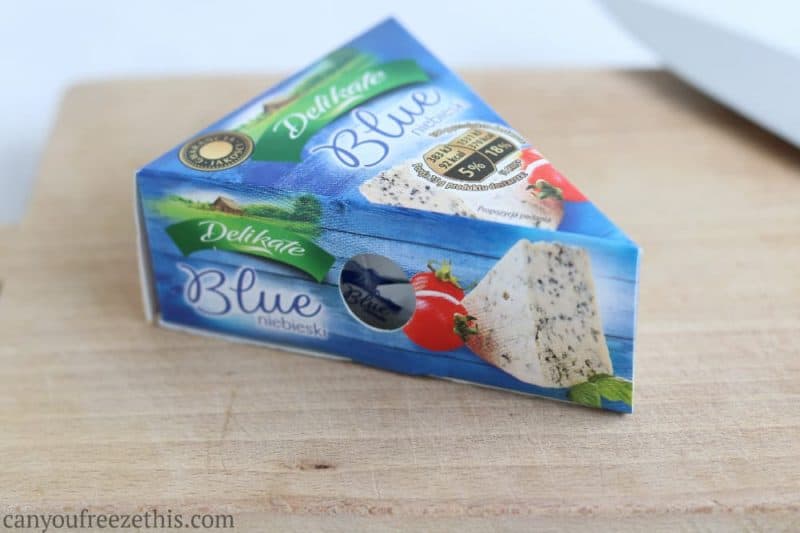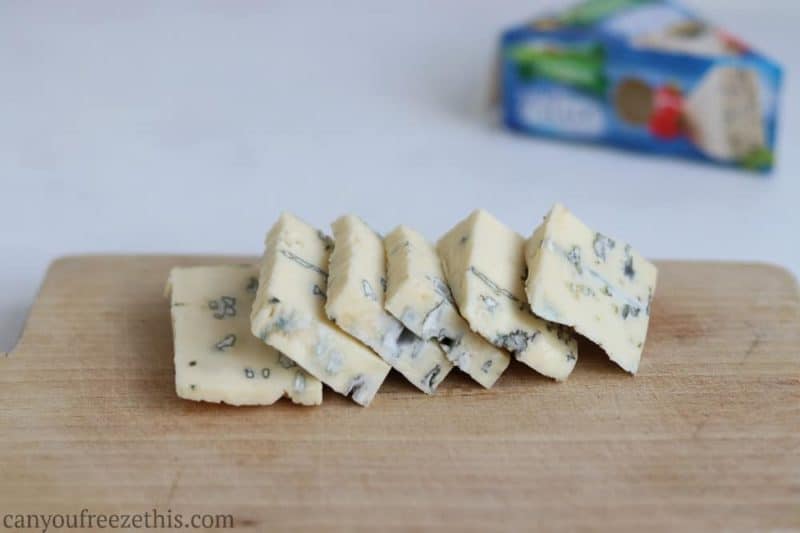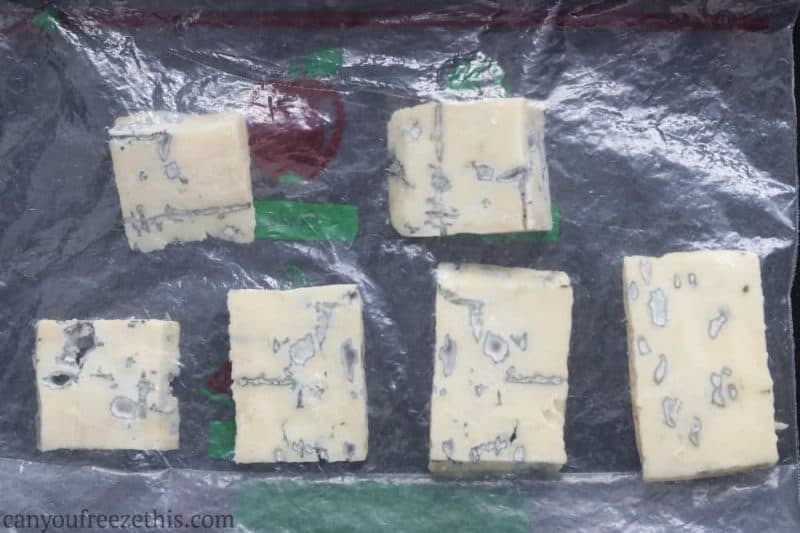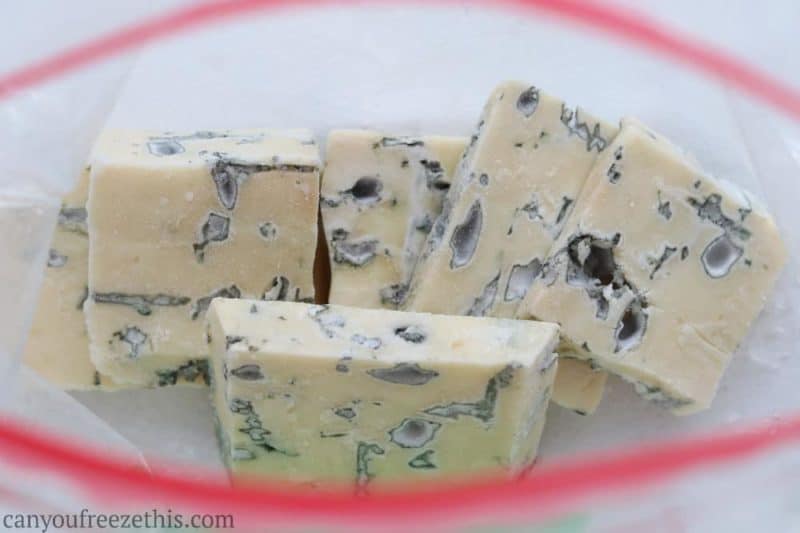Even though blue cheese isn’t as popular as Brie or Camembert, it has its loyal fans. If you’re one of them and bought more than you can use before its date, you’re probably looking for ways to extend its shelf life. Same thing if you purchase this dairy product only for specific recipes, and you’d like to save the leftovers.
Either way, freezing is probably the first thing that came to your mind, and for a reason. It usually doesn’t require any extra tools, and pretty much everyone has access to a freezer, so why not take advantage of it, right? The logic here is perfectly sound, but as it turns out, freezing blue cheese isn’t always a good idea. Let’s talk about that in more detail.

Can You Freeze Blue Cheese?
The best answer I can come up with is: it depends. Blue cheese, just like Brie, freezes quite well, but that doesn’t mean defrosted blue cheese works well in all settings.
Like with Brie, freezing changes its texture slightly and makes it less creamy (FD). The taste might also be somewhat distorted. That means that it might not work that great in dishes that depend on its texture. In other words, think twice before adding defrosted blue cheese to a salad or cheese platter. In cooked dishes, on the other hand, it works quite well, as those don’t depend on the creaminess or crumbliness of the product.
Before you go ahead and freeze your blue cheese, make sure to check how long does it last. Its shelf life isn’t impressive, but maybe you can avoid freezing it and still eat it fresh.
All in all, feel free to freeze the cheese with blue veins, but remember about the constraints. It’s probably best if you know for what recipe you’re going to need the cheese, as that helps with the freezing process.
If you’re not sure how you can use thawed blue cheese, you can find some great examples later in the article.
Can you freeze blue cheese crumbles, you ask? Sure you can, and the process is the same as for wedges of blue. Please note, however, that an unopened box of blue cheese crumbles has a pretty long shelf life, and often you can refrigerate it until you need it. Freeze the crumbles only if you must to.
How To Freeze Blue Cheese?
As mentioned above, it’s best to know how you’re going to use the blue cheese after thawing before you freeze it. This way, you can package and wrap it in a way that makes sense for you, and it often cuts the time needed to prep it for use to a minimum. If you don’t have that planned out yet, and you can’t be bothered with it right now, we’ve got some tips for you too, so don’t worry.
Here’s how I go about the freezing process:
- Cut and portion the cheese. If you know how you’re going to use it later, choosing how to go about it is simple. If you don’t, there are a couple of options. You can slice it, cube it, grate it, cut into a few larger pieces, or leave as is. Each has its pros and cons. When in doubt, go with cubing or slicing. Either of these gives you the ability to thaw only a small amount of blue cheese, so you’re covered no matter how you’re going to use the cheese.

Sliced blue cheese - Package it. This step depends heavily on the previous one. You can leave the whole wedge in its original packaging, or chuck it into a freezer bag for extra protection. Larger pieces you can wrap with plastic or aluminum wrap, and then in a freezer bag. Skip the wrapping if you’re going to freeze the portions short term (like 1 – 2 months, tops). For slices and cubes, I freeze all of them in a single freezer bag on top of a cookie sheet, so they don’t freeze together. Once they’re frozen, I remove the sheet. Last but not least, freeze grated blue cheese in a freezer bag.

Sliced blue cheese in a freezer bag - Finalize packaging. Remember to always remove air from the bag before sealing it. If you’re worried that the cheese might get squashed, feel free to put that bag in a plastic container for extra safety. If you find it helpful, add a label with name and date on the package.
- Stick it in the freezer. Once it’s frozen, it looks like this:

Frozen blue cheese slices
If you’re going to use the blue cheese in a sauce or topping, and you typically grate it before throwing it in, take care of that before freezing. This way it thaws more quickly, and in many cases you can skip defrosting it whatsoever.
How Long Can You Store Frozen Blue Cheese?
Depending on whom you ask, blue cheese can sit in the freezer for between 6 months (NCHFP, FD) and a year (MDF).
How To Defrost Blue Cheese?
Defrosting blue cheese is no rocket science. Take the package from the freezer and put it in the refrigerator. Make sure the blue-spotted cheese has enough time to thaw before you need it. That time, of course, depends on how you froze it, but overnight thawing is usually a safe bet. Unless you’ve frozen a whole big wedge, in which case you might need up to 24 hours or even two days to defrost it fully.
If you’re in a hurry, you can thaw the dairy product in cold water. Or throw it in frozen in the pot or skillet you’re cooking the dish in. More rapid defrosting usually yields slightly worse results than doing it slowly in the fridge, but since you’re going to cook or bake that cheese either way, it shouldn’t matter that much.
Cutting the cheese into smaller pieces significantly reduces the time needed to thaw it.
How To Use Defrosted Blue Cheese?
If you’re wondering about how to use thawed blue cheese, we’ve got you covered. Here are a few popular options for you to choose from:
- Grilled sandwiches. Yeah, Brie and Camembert aren’t the only kinds of cheese that you can grill.
- Toppings and sauces. There’s a whole lot of topping and sauce recipes that call for blue cheese.
- Soups. Blue cheese can add creaminess to many vegetable soups.
- Casseroles. Cubes or shredded cheese is always a great finishing touch for a casserole, and blue works well for that too.
- Stews.
More often than not finding a great recipe for thawed blue cheese is as simple as googling a phrase like “blue cheese [other ingredients you have] recipe.”
Once you thawed the dairy product, use it within a day or two for best results. If you can’t use all of it, and you’ve defrosted it in the fridge, it’s probably safe to refreeze it.
Of course, twice-frozen blue cheese will be worse in terms of taste and texture than once-frozen, so refreeze only if you have no other options.
Have more questions about freezing in general? Check out our freezing FAQ.
How Long Blue Cheese Lasts?
Blue cheese typically lasts much longer than brie. A wedge usually lasts about two months, while crumbles even up to half a year. Of course, for both varieties there’s a date on the label that you should observe. For wedges, the cheese should be at peak quality for up to maybe a week past that date. When it comes to crumbled blue, that’s closer to two weeks, provided you didn’t open the container yet.
Please note that if your cheese is nearing or past its date, always check if it’s spoiled before eating. Here are some of the signs that your blue cheese is bad:
- Changes of appearance or texture (e.g., the flesh turning green or pink, or losing its firmness)
- Mold that’s not native to the cheese
- Ammonia-like or any other off smell
If old blue cheese is more biting that it usually is, that’s okay. That happens over time and it’s quite normal ([CC]).
References
- FD Faribault Dairy: FAQ
- MDF Maytag Dairy Farms
- NCHFP National Center for Home Food Preservation: Freezing Cheese
- WIKI Wikipedia: Blue Cheese
- CC Castello Cheese: How To Store Cheese
About the Author

Marcin is the managing editor of CanYouFreezeThis.com. He is making sure all the freezing info on this page is accurate and the posts easy to digest and use.